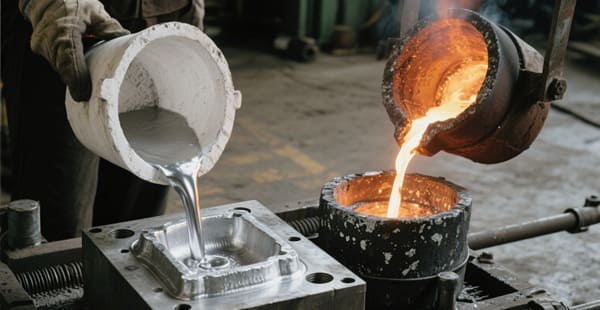5 Major Advantages of Using Alumina Crucibles Over Graphite for Metal Melting
In metal melting industries, choosing the right crucible material is essential for ensuring product quality, efficiency, and safety. Crucibles must withstand extreme temperatures, resist chemical reactions with molten metals, and maintain mechanical integrity through thermal cycling. Among commonly used crucibles, graphite and alumina dominate due to their outstanding but distinct properties. Graphite crucibles are prized for their ultra-high temperature capabilities and excellent thermal conductivity, while alumina crucibles are renowned for their chemical inertness and mechanical durability. This article explores the fundamental differences between graphite and alumina crucibles and why alumina stands out as the better choice for many metal melting applications, especially in high-purity and advanced manufacturing environments such as magnetic materials production. By understanding these differences and the five key advantages of alumina crucibles, manufacturers can optimize their melting processes for better performance, longer service life, and improved product quality.
At Advanced Ceramic Hub, we specialize in high-quality alumina crucible products, ensuring optimal performance for industrial and scientific applications.

What Are Graphite and Alumina Crucibles?
Graphite crucibles are produced by compressing and baking high-purity graphite powders into solid blocks. They offer extremely high melting points (around 3000 °C), excellent thermal conductivity (~120 W/m·K), and superior thermal shock resistance. These features make them ideal for rapid heating and cooling cycles in vacuum or inert gas environments. However, graphite reacts readily with oxygen at elevated temperatures, leading to oxidation and degradation if exposed to air.
Alumina crucibles are ceramic vessels made from aluminum oxide (Al₂O₃), typically with a purity above 99.5%. Alumina offers excellent chemical stability, mechanical hardness, and thermal stability up to about 2050 °C. While their thermal conductivity (~25 W/m·K) is lower than graphite’s, their inertness to molten metals and slags makes them invaluable in applications where contamination and durability are critical.
Basic Properties Comparison
| Property | Graphite Crucible | Alumina Crucible |
| Max Service Temp | ~3000 °C | ~2050 °C |
| Thermal Conductivity | Very High (120 W/m·K) | Moderate (25 W/m·K) |
| Chemical Stability | Poor in oxidizing env. | Excellent |
| Mechanical Strength | Moderate | High |
| Cost | Low | Moderate |
| Typical Applications | Vacuum melting, carbides | High-temp metals, ceramic sintering |
Explore our high-quality alumina crucible products.
What Are the Strengths of Graphite Crucibles?
Graphite crucibles’ outstanding thermal conductivity enables fast and uniform heat distribution, which is vital in processes requiring rapid heating and cooling. Their ultra-high melting point also permits melting refractory metals like tungsten and carbides. Additionally, graphite is relatively inexpensive and machinable, which allows for customized shapes and sizes.
Key Advantages of Graphite Crucibles
- Exceptionally high temperature tolerance up to 3000 °C
- Excellent thermal conductivity for uniform temperature control
- Superior thermal shock resistance minimizes cracking during rapid temperature changes
- Cost-effective and widely available
- Suitable for vacuum and inert atmosphere melting processes
These benefits make graphite crucibles a go-to choice for certain applications like vacuum melting of carbides, but their drawbacks limit their broader use.
What Are the Drawbacks of Graphite Crucibles?
Graphite crucibles have significant disadvantages primarily related to chemical stability and contamination. At high temperatures in air or oxidizing atmospheres, graphite oxidizes, losing mass and structural integrity. This limits their use mainly to vacuum or inert gas environments. Furthermore, graphite’s carbon content can diffuse into molten metals, contaminating sensitive alloys or materials requiring ultra-high purity, such as those used in magnetic components or electronics. Their moderate mechanical strength also makes them more susceptible to cracking during handling or thermal cycling compared to ceramic crucibles.
Limitations of Graphite Crucibles:
| Limitation | Description | Impact on Application |
| Oxidation risk | Reacts with oxygen at high temps | Not suitable for open-air melting |
| Carbon contamination | Carbon diffusion into melts | Reduces purity, problematic for sensitive metals |
| Mechanical brittleness | Moderate mechanical strength | Susceptible to cracking and damage during handling |
| Limited chemical stability | Reacts with fluxes and slags | Restricts use in aggressive chemical environments |
These limitations have steered many precision melting processes to rely on alumina crucibles despite higher initial costs.
What Are the 5 Key Benefits of Alumina Crucibles?
Alumina crucibles excel in providing a combination of chemical inertness, mechanical durability, and thermal stability that graphite cannot match in many applications. Below are five reasons alumina is favored:
5 Key Benefits of Alumina Crucibles:
| Benefit | Explanation | Result for Metal Melting |
| 1. Chemical Inertness | Resistant to reactions with molten metals, slags, and fluxes | Preserves melt purity, critical for high-grade alloys |
| 2. Thermal Stability | Stable up to ~2050 °C without structural damage | Allows melting of most high-temp metals safely |
| 3. Mechanical Strength | High hardness and fracture toughness compared to graphite | Less prone to mechanical damage and cracking |
| 4. Thermal Shock Resistance | Moderately resistant to rapid temperature changes when properly handled | Reduces risk of cracking, extends crucible life |
| 5. Compatibility with Vacuum/Inert Atmospheres | Performs reliably in controlled atmospheres for reactive or sensitive melts | Essential for metals like LaB6 and materials for magnets |
These attributes make alumina crucibles indispensable in industries where metal purity, product consistency, and operational reliability are paramount.
How Do Alumina Crucibles Compare to Graphite in Metal Melting?
Graphite crucibles dominate when the absolute maximum temperature and rapid heating are required, especially in vacuum or inert atmospheres. However, alumina crucibles outperform graphite where chemical inertness, mechanical strength, and contamination avoidance are needed. This makes alumina the ideal choice for metals sensitive to carbon contamination, such as titanium and specialty alloys used in magnetic materials. Furthermore, alumina crucibles’ ability to resist flux attack broadens their application range in metallurgical processes involving aggressive chemical environments.
Performance Comparison for Metal Melting:
| Criteria | Graphite Crucibles | Alumina Crucibles |
| Maximum Temperature | Up to 3000 °C | Up to 2050 °C |
| Chemical Stability | Limited in oxidizing env. | Excellent |
| Mechanical Durability | Moderate | High |
| Thermal Conductivity | Very High | Moderate |
| Purity of Melt | Risk of carbon contamination | High purity maintained |
| Cost | Lower | Moderate |
| Best Use Cases | Vacuum melting, carbides | High-purity metals, ceramics |
Request a custom quote for the alumina crucibles product.
What Are Common Applications of Alumina Crucibles?
Alumina crucibles are used extensively in sectors demanding metal purity and durability. These include aerospace, electronics, semiconductor industries, and magnetic materials manufacturing. They are ideal for melting refractory metals such as titanium, platinum, molybdenum, and LaB6—a lanthanum hexaboride compound critical in electron emission devices.
Typical Applications of Alumina Crucibles:
- Melting refractory metals, including titanium and platinum
- Sintering ceramics for electronic and magnetic components
- Processing LaB6 for thermionic emitters and plasma applications
- Conducting high-temperature chemical reactions in a controlled atmosphere
- Semiconductor and advanced material manufacturing
Their combination of chemical resistance and mechanical strength ensures process reliability and superior end-product quality.
FAQ
| Question | Answer |
| Yes, especially under vacuum or inert gases, where oxidation is prevented. | Yes, alumina is much more oxidation-resistant than graphite but controlled heating is advised. |
| Are graphite crucibles better for ultra-high temperatures? | Yes, alumina is much more oxidation-resistant than graphite, but controlled heating is advised. |
| How resistant are alumina crucibles to thermal shock? | Moderate resistance; thermal cycling must be controlled to prevent cracking. |
| Which crucible type is better for magnetic materials? | Alumina, due to its chemical inertness and ability to maintain purity. |
| What is the typical lifespan difference? | Alumina crucibles typically last longer with proper use and care. |
| Are alumina crucibles more expensive? | Yes, but the benefits in durability and purity justify the investment. |
Conclusion
Both graphite and alumina crucibles have their roles in metal melting, but alumina crucibles offer clear advantages for processes requiring high purity, chemical stability, and mechanical durability. Especially in advanced applications like magnetic materials manufacturing and LaB6 processing, alumina crucibles deliver unmatched reliability and product quality. Selecting the right crucible material is essential for optimizing melting operations, extending crucible life, and ensuring superior metal performance. As manufacturing demands continue to evolve, alumina crucibles will remain a top choice for high-temperature melting processes worldwide.
Looking for high-quality alumina crucible products? Contact us today!
